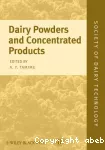1 Chemistry of Milk - Role of Constituents in Evaporation and Drying
1 Chemistry of Milk - Role of Constituents in Evaporation and Drying
+
-





